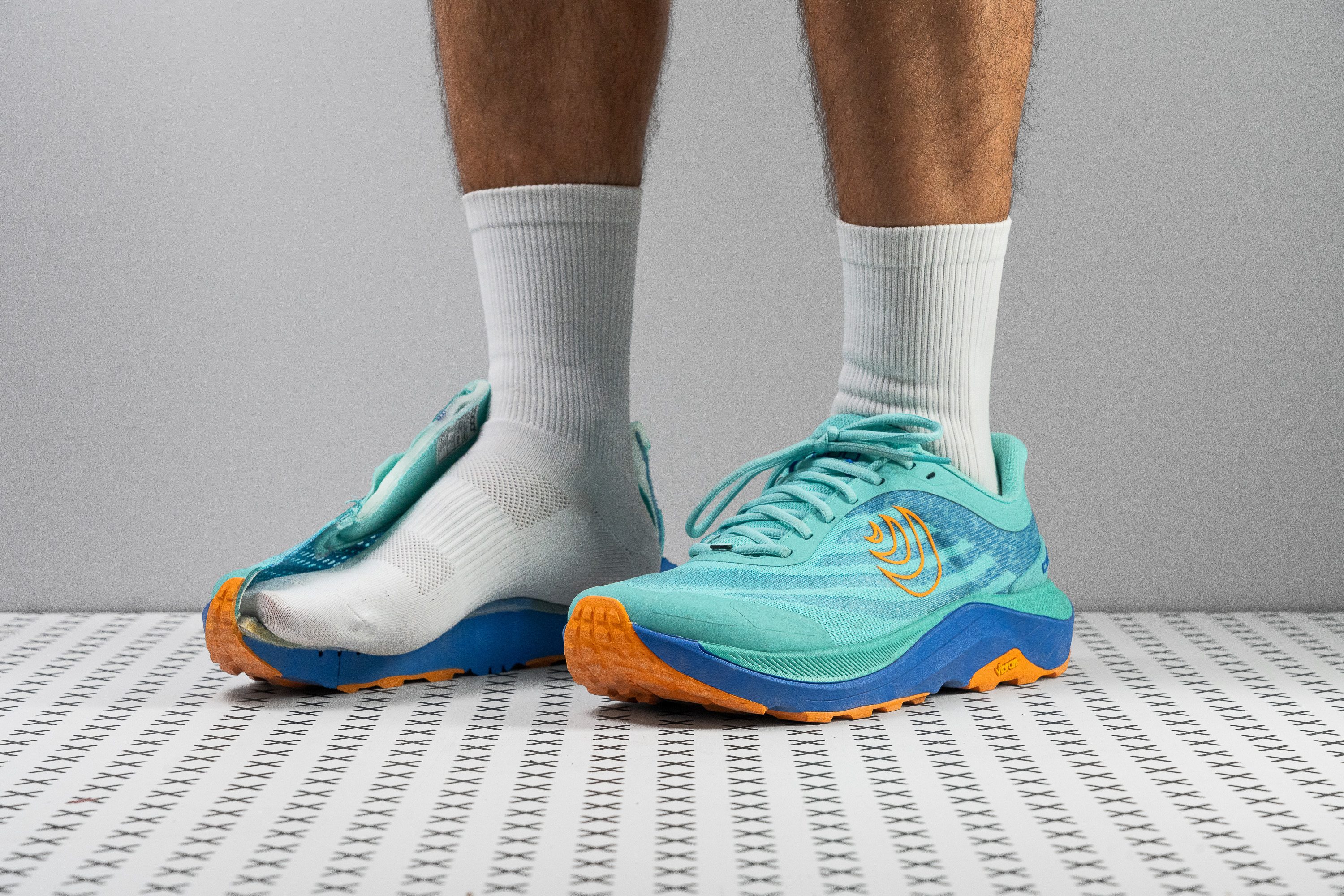Our verdict
- Top pick in best ultra running shoes
- Top pick in best running shoes for hiking
Pros
- Extra-roomy toebox
- Hardwearing Vibram outsole
- More flexible and comfortable than version 3
- Ideal for midfoot strikers
- Can handle ultra races
- Plush tongue improves comfort
- Excellent stability in the forefoot area
- Good lockdown with no tongue movement
Cons
- Not for narrow-footed runners
- Midsole lacks energy return
- No reflective elements
- Unstable heel
Audience verdict
Comparison
The most similar running shoes compared
+ + Add a shoe | |||||
|---|---|---|---|---|---|
| Audience score | 85 Good! | 85 Good! | 88 Great! | 69 Bad! | |
| Price | £150 | £150 | £160 | £150 | |
| Trail terrain | Light | Light | Light | LightModerate | |
| Shock absorption | Moderate | Moderate | Moderate | Moderate | |
| Energy return | Low | Moderate | Moderate | Low | |
| Traction | - | High | High | High | |
| Arch support | Neutral | Neutral | Neutral | Neutral | |
| Weight lab Weight brand | 10.1 oz / 286g 10.1 oz / 285g | 11 oz / 312g 10.9 oz / 309g | 11 oz / 312g 0.2 oz / 5g | 10.2 oz / 289g | |
| Drop lab Drop brand | 6.6 mm 5.0 mm | 6.5 mm 6.0 mm | 6.1 mm 5.0 mm | 7.6 mm 6.0 mm | |
| Strike pattern | Mid/forefoot | Mid/forefoot | Mid/forefoot | Mid/forefoot | |
| Size | True to size | - | Half size small | - | |
| Midsole softness | Soft | Soft | Balanced | Balanced | |
| Difference in midsole softness in cold | Small | Normal | Small | Small | |
| Toebox durability | Bad | Decent | Decent | Decent | |
| Heel padding durability | Decent | Bad | Good | Decent | |
| Outsole durability | Good | Decent | Decent | Good | |
| Breathability | Moderate | Moderate | Moderate | Moderate | |
| Width / fit | Wide | Medium | Medium | Medium | |
| Toebox width | Wide | Medium | Medium | Wide | |
| Stiffness | Moderate | Moderate | Stiff | Moderate | |
| Torsional rigidity | Moderate | Stiff | Stiff | Moderate | |
| Heel counter stiffness | Flexible | Stiff | Stiff | Flexible | |
| Lug depth | 3.2 mm | 3.5 mm | 3.1 mm | 3.4 mm | |
| Heel stack lab Heel stack brand | 35.1 mm 35.0 mm | 37.6 mm 36.0 mm | 39.3 mm 41.0 mm | 37.1 mm | |
| Forefoot lab Forefoot brand | 28.5 mm 30.0 mm | 31.1 mm 30.0 mm | 33.2 mm 36.0 mm | 29.5 mm | |
| Widths available | NormalWide | Normal | Normal | NormalWide | |
| Season | All seasons | All seasons | All seasons | All seasons | |
| Removable insole | ✓ | ✓ | ✓ | ✓ | |
| Orthotic friendly | ✓ | ✓ | ✓ | ✓ | |
| Ranking | #216 Bottom 41% | #200 Bottom 46% | #139 Top 38% | #367 Bottom 1% | |
| Popularity | #157 Top 43% | #186 Top 50% | #116 Top 32% | #347 Bottom 6% |
Who should buy
After testing the Topo Ultraventure 4 in the lab, we believe it's a solid option for:
- Runners with wide feet looking for a long-distance-ready shoe that offers generous toe splay and comfort.
- Loyal Topo fans who want a dependable trail shoe and aren’t interested in switching brands.
- Midfoot strikers who prefer a moderate drop: neither too high nor completely flat.
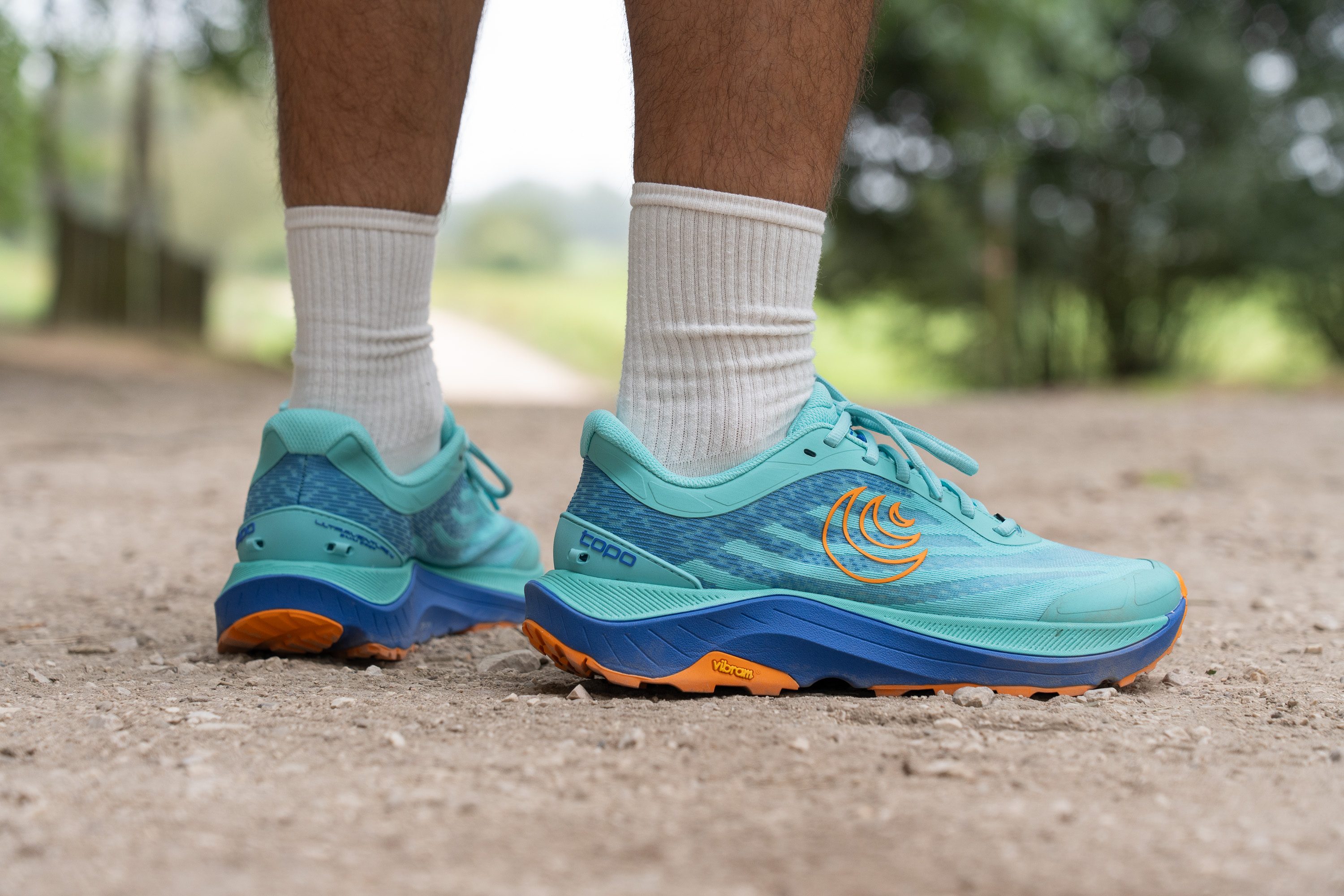
Who should NOT buy
We believe that the Ultraventure 4 isn't the best pick for runners chasing a bounce-filled ride. After lab testing, we found its EVA-based midsole offers limited energy return, making it less suitable for those hoping to shave time during long sessions or races. For a more propulsive experience in the same price range, we recommend the Saucony Xodus Ultra 3 or New Balance Fresh Foam X Hierro v9 instead.
Additionally, we’re convinced that runners with narrow feet might find the spacious upper too loose. If a tight and secure fit matters to you, we suggest trying the Merrell Agility Peak 5 or the Saucony Peregrine 15.
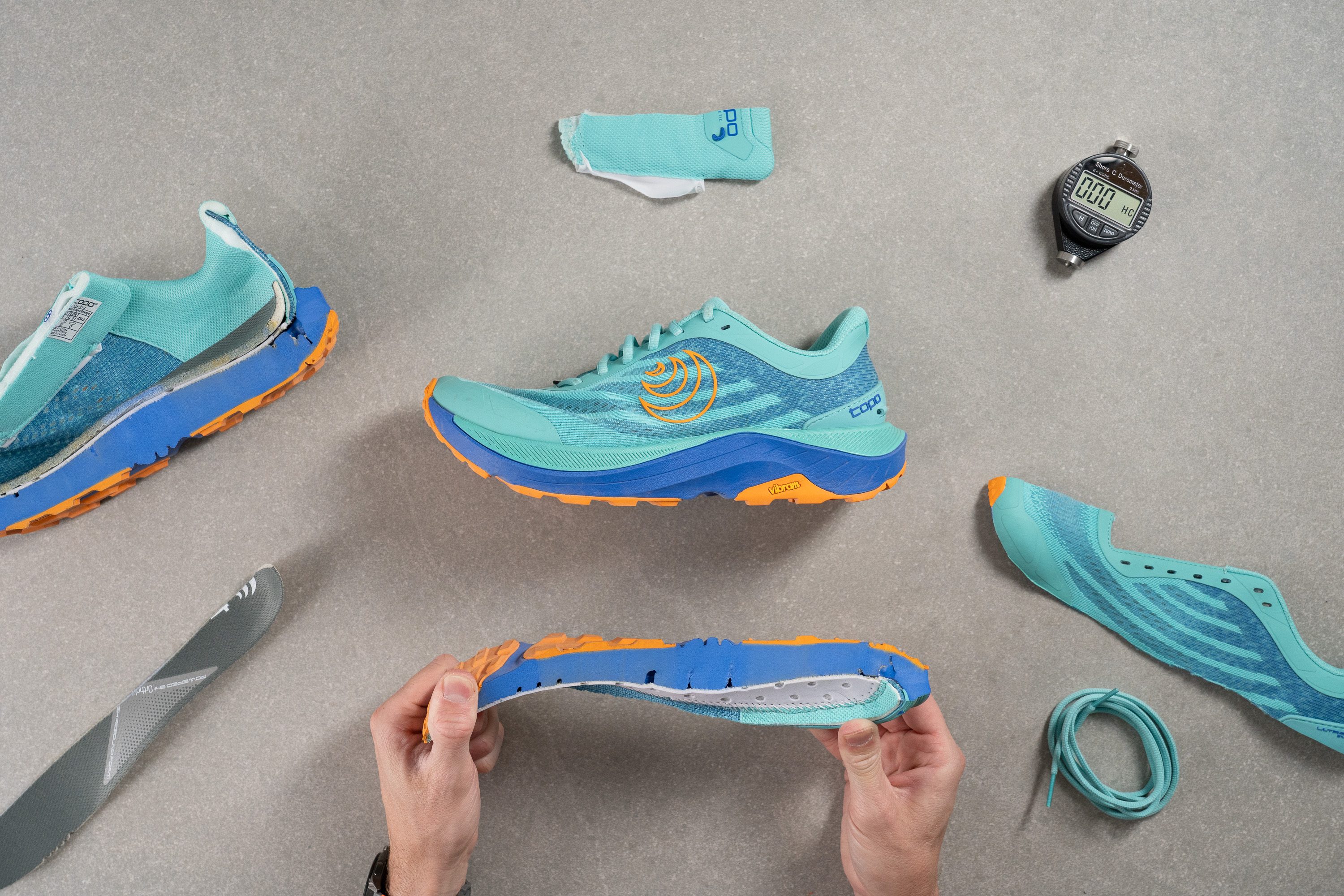
Cushioning
Shock absorption
We measured solid shock absorption at 129 SA in the heel and 107 SA in the forefoot. While not jaw-dropping, these are dependable numbers that provide reliable protection for long runs and trail adventures.

| Topo Ultraventure 4 | 129 SA |
| Average | 122 SA |
Energy return
Topo kept the same ZipFoam from the Ultraventure 3, and unfortunately, that means energy return is far from impressive.
In our lab tests using the ASTM F1976 standard, we measured just 50.5% in the heel and 55.0% in the forefoot. These numbers clearly suggest it’s time for Topo to bring their Pebax foam into the Ultraventure line.
| Topo Ultraventure 4 | 50.5% |
| Average | 55.6% |
Heel stack
Topo lists the heel stack height at 35 mm, and after multiple measurements, we confirmed 35.1 mm. That puts it firmly in high-stack territory, true to the Ultraventure name and clearly built for long-distance comfort.
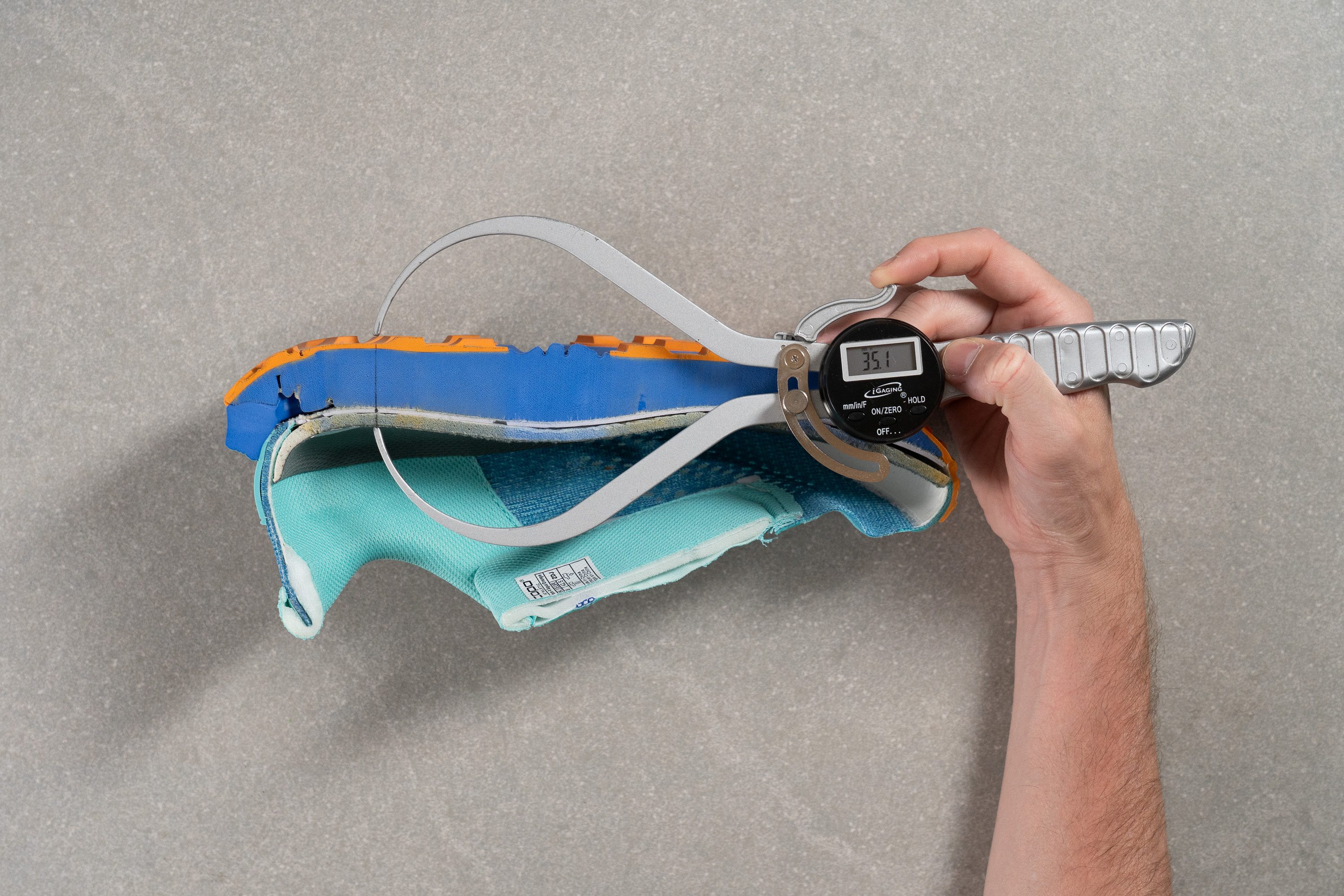
| Topo Ultraventure 4 | 35.1 mm |
| Average | 32.6 mm |
Forefoot stack
The forefoot came in slightly shorter than expected. Topo claims 30 mm, but we measured 28.5 mm. Nonetheless, it's a minor difference that even sensitive runners are unlikely to notice underfoot.

| Topo Ultraventure 4 | 28.5 mm |
| Average | 25.1 mm |
Drop
That forefoot discrepancy results in a slight shift in drop, from the stated 5 mm to our measured 6.6 mm. It's still moderate and delivers the classic Topo feel, definitely flatter than most brands but not quite zero-drop like Altra.
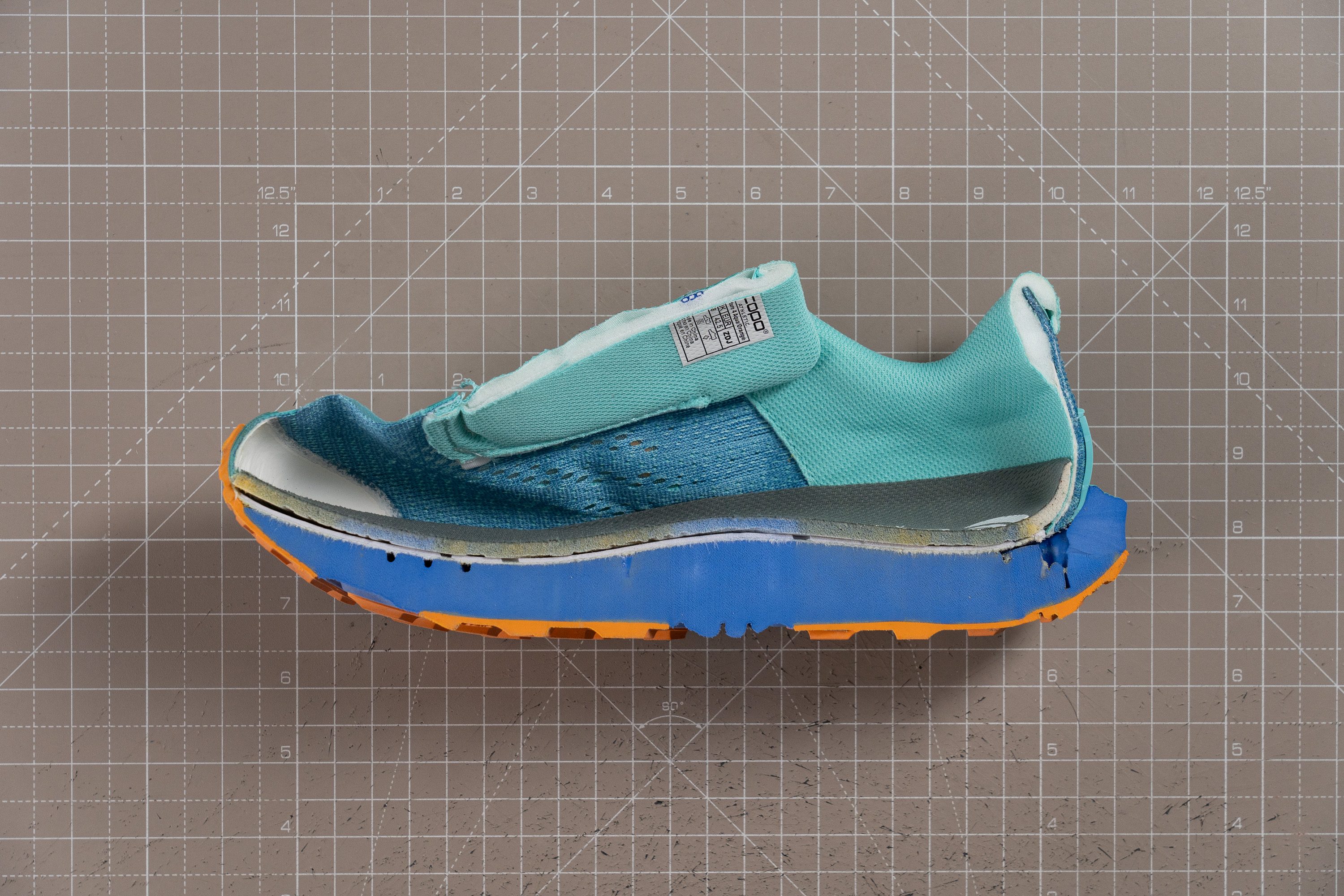
| Topo Ultraventure 4 | 6.6 mm |
| Average | 7.5 mm |
Midsole softness
The EVA-based ZipFoam compound isn’t bouncy, but it feels softer than the average trail midsole.
We tested it with our Shore A durometer and measured 16.6 HA. That's clearly designed for a comfort-seeking, soft ride.
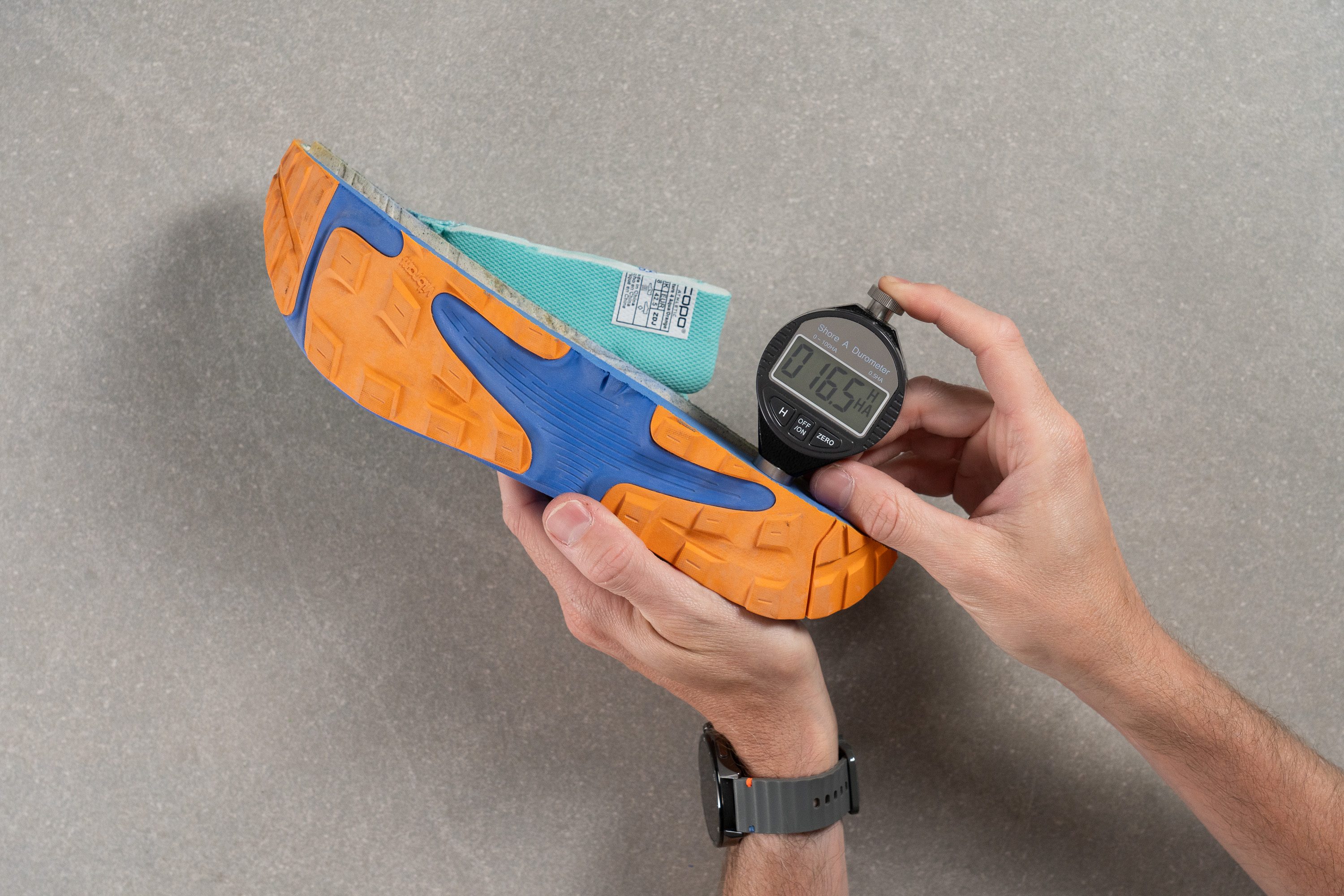
| Topo Ultraventure 4 | 16.6 HA |
| Average | 21.9 HA |
Rocker
The Topo Ultraventure 4 features a comfort-focused rocker geometry with both heel and forefoot curves. The heel rocker begins just behind the heel base, promoting smooth landings and gentle transitions on descents or uneven terrain.
Up front, the forefoot rocker is mildly extended, easing toe-offs without being overly aggressive. In our view, it's built for long-distance comfort rather than fast, explosive rides. Just like the foam itself.
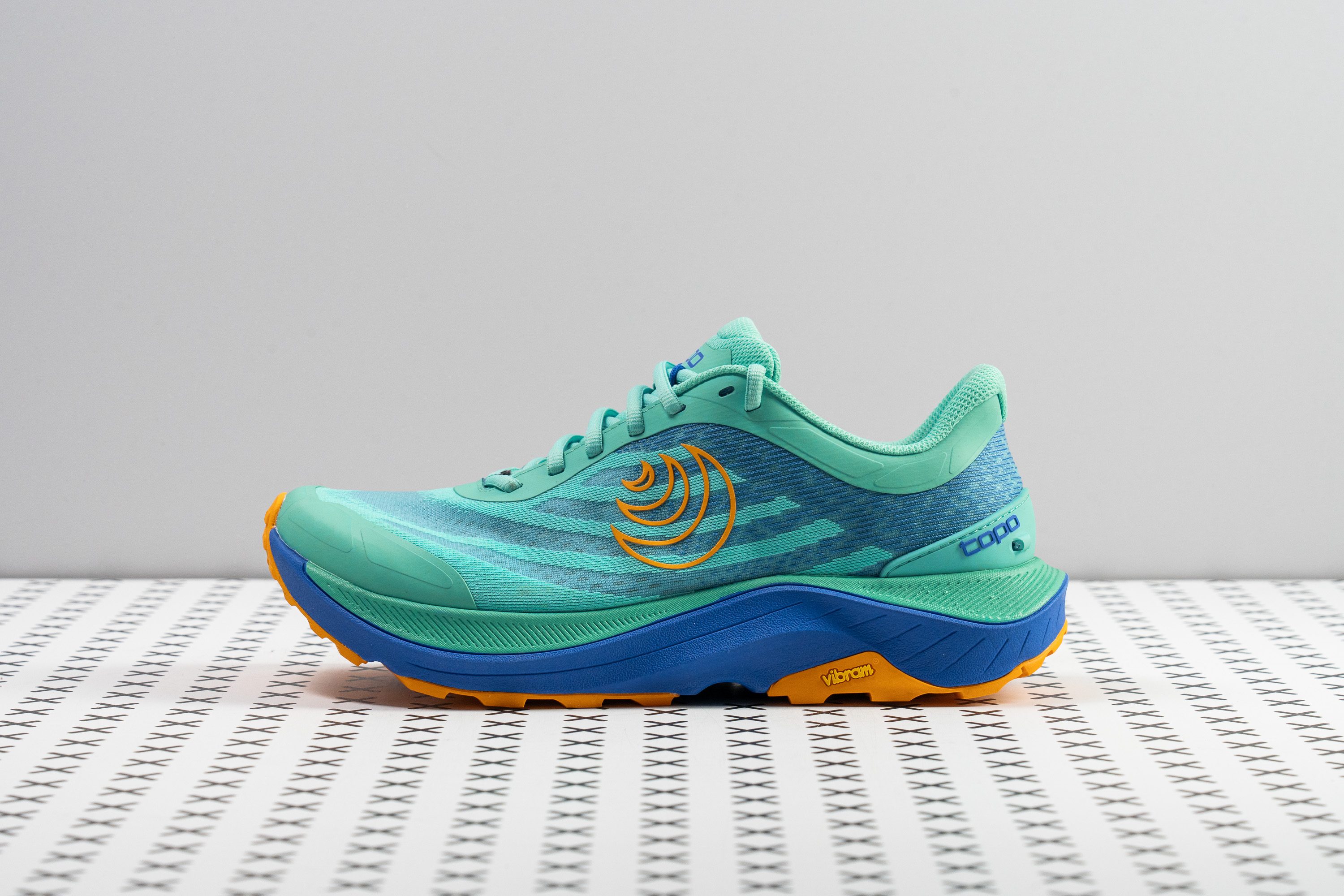
Size and fit
Size
Topo Ultraventure 4 fits true to size (37 votes).
Width / Fit
One of the standout traits of every Topo shoe is the spacious fit it provides. To see if the Ultraventure 4 carries that same identity, we created yet another gel mould in the lab.
Our first measurement came in at 99.0 mm with the callipers. That's a figure that easily earns the "roomy" label... but of course, we didn’t stop there.
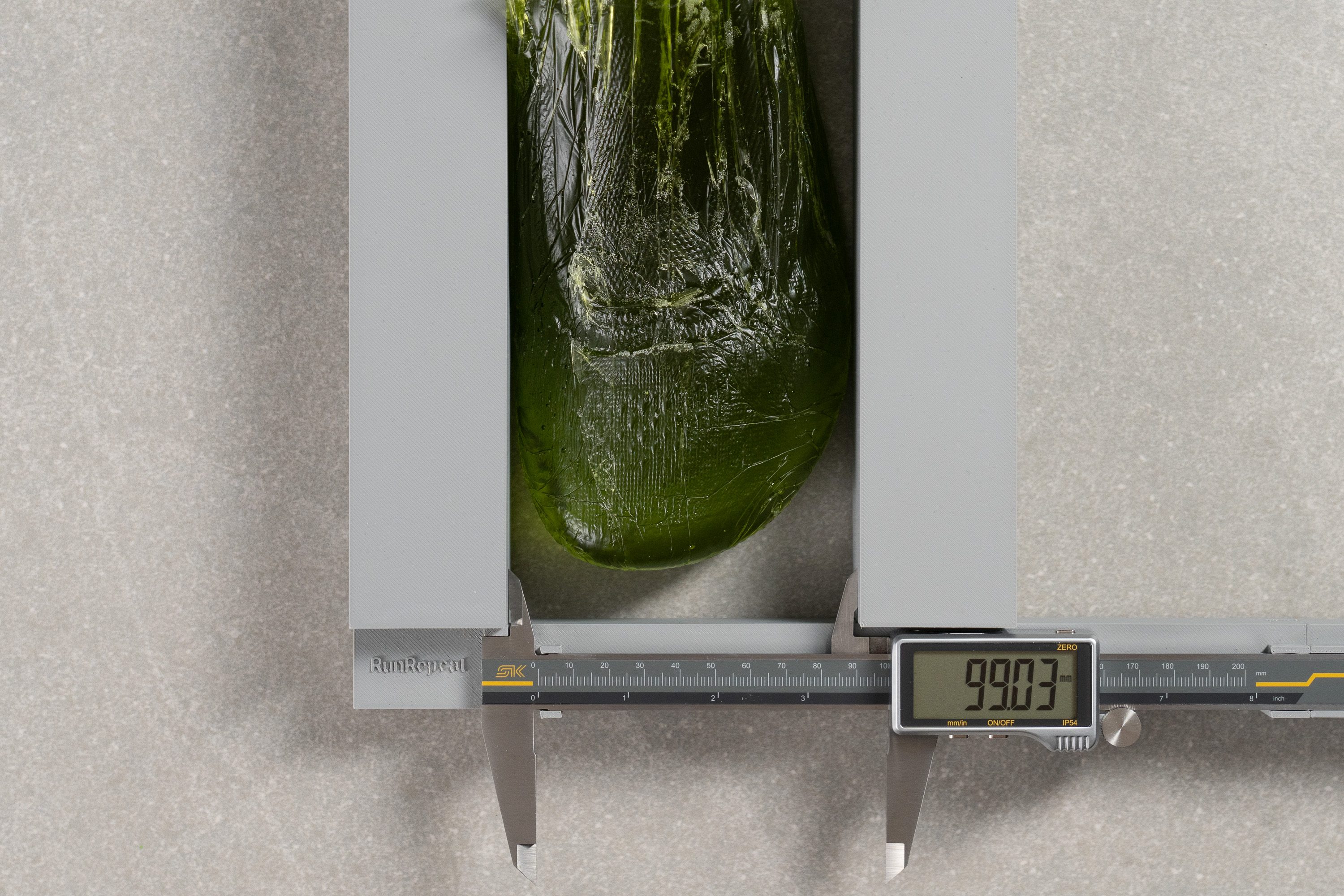
| Topo Ultraventure 4 | 99.0 mm |
| Average | 95.7 mm |
Toebox width
Arguably the most important measurement for anyone wanting a spacious fit is this one, and the Ultraventure 4 delivers.
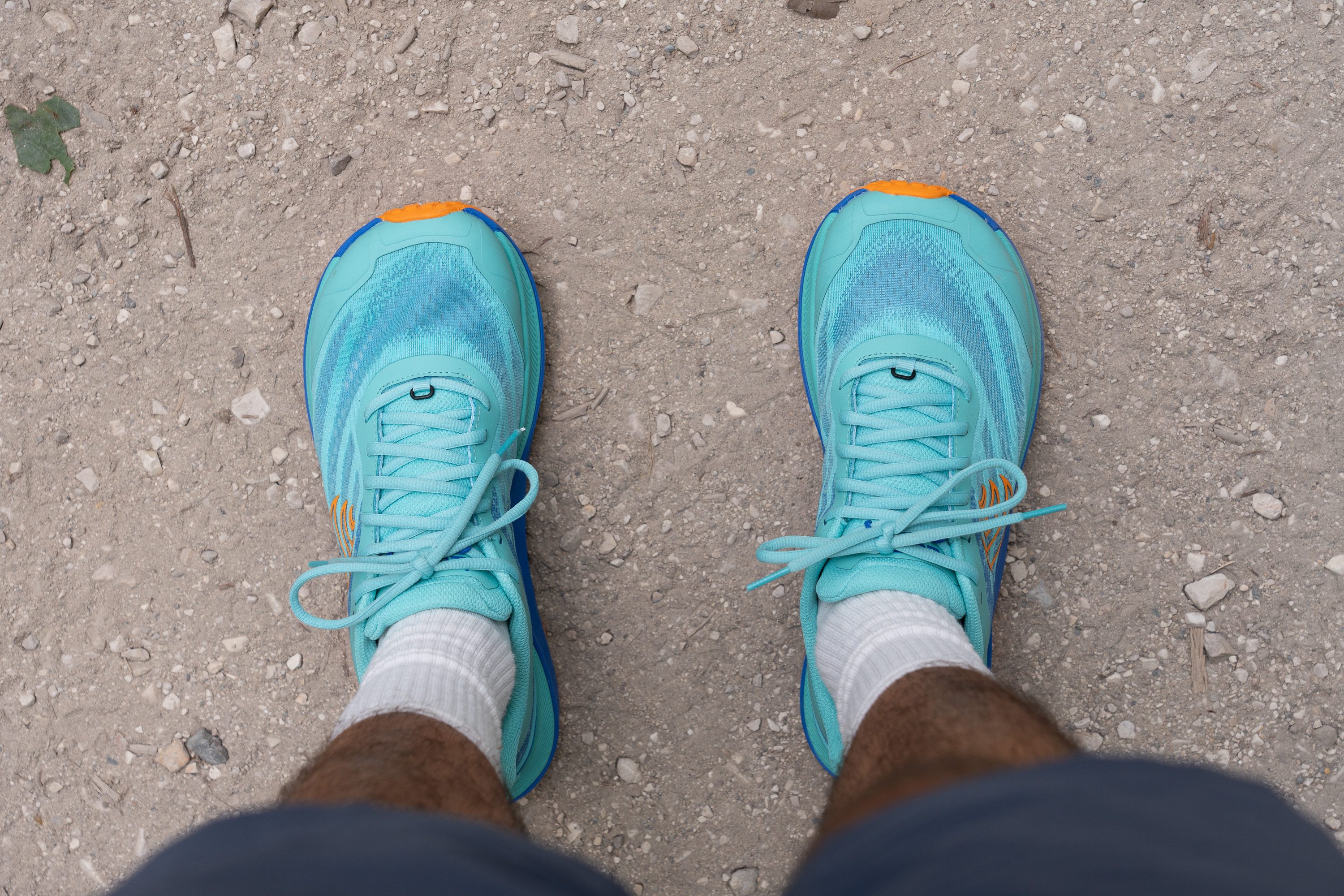
With its signature foot-shaped toebox, it offers an impressive 83.0 mm width that allows outstanding toe splay.

| Topo Ultraventure 4 | 83.0 mm |
| Average | 74.7 mm |
Toebox height
Vertical clearance is outstanding too, rounding out the trio of ultra-spacious measurements in the upper with a high-volume, pressure-free feel that enhances comfort on longer efforts.
We measured 29.7 mm here. It's a high toebox height that provides a smash-free, ultra-relaxed fit for the toes. Ideal for your next 100-miler!
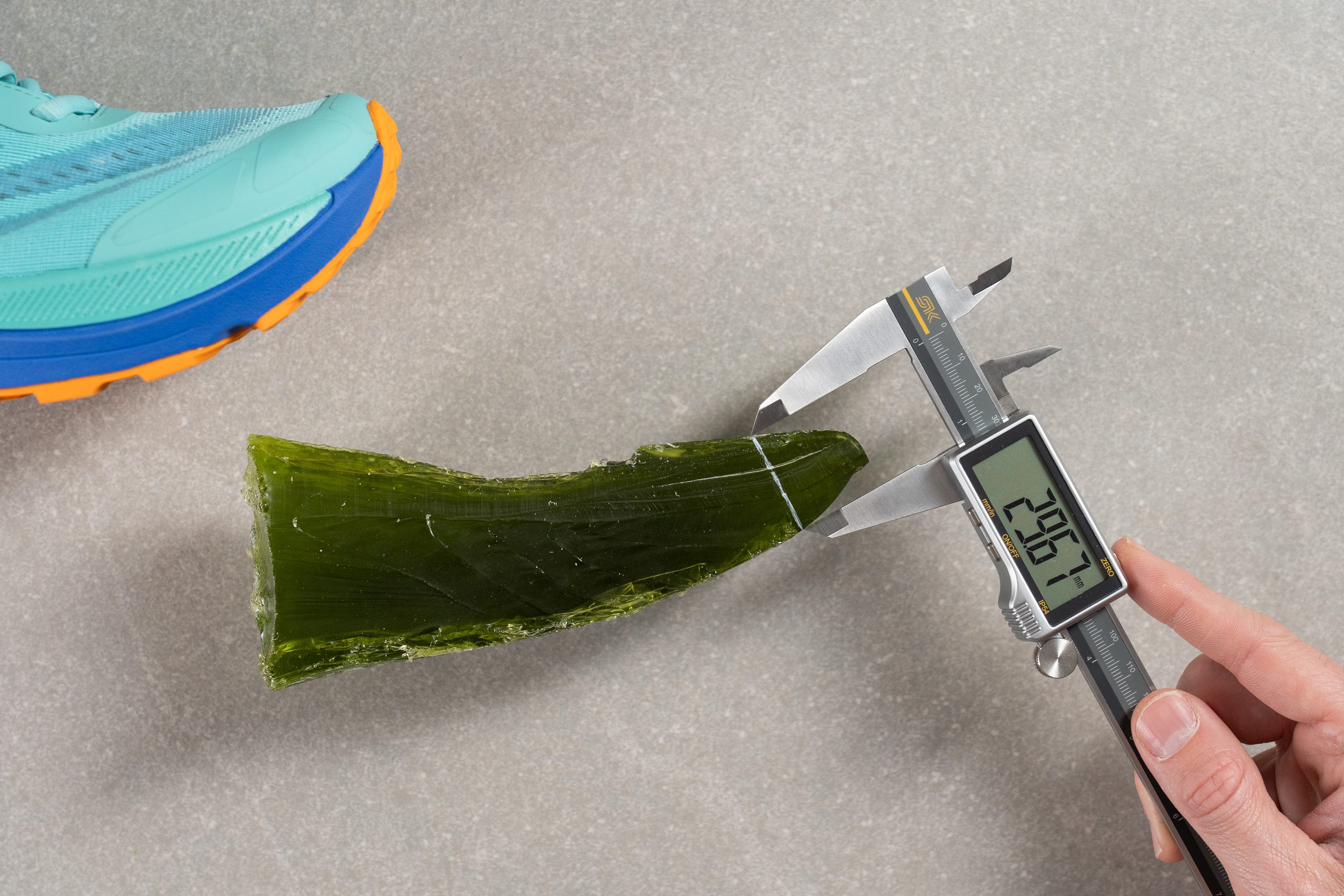
| Topo Ultraventure 4 | 29.7 mm |
| Average | 27.1 mm |
Traction / Grip
Lug depth
It's clear to us that the Ultraventure 4 was designed with US-style ultras in mind, definitely more Western States than Ultra-Trail de Mont-Blanc. That explains the shallow lugs, which measure just 3.2 mm and suit non-technical terrain.
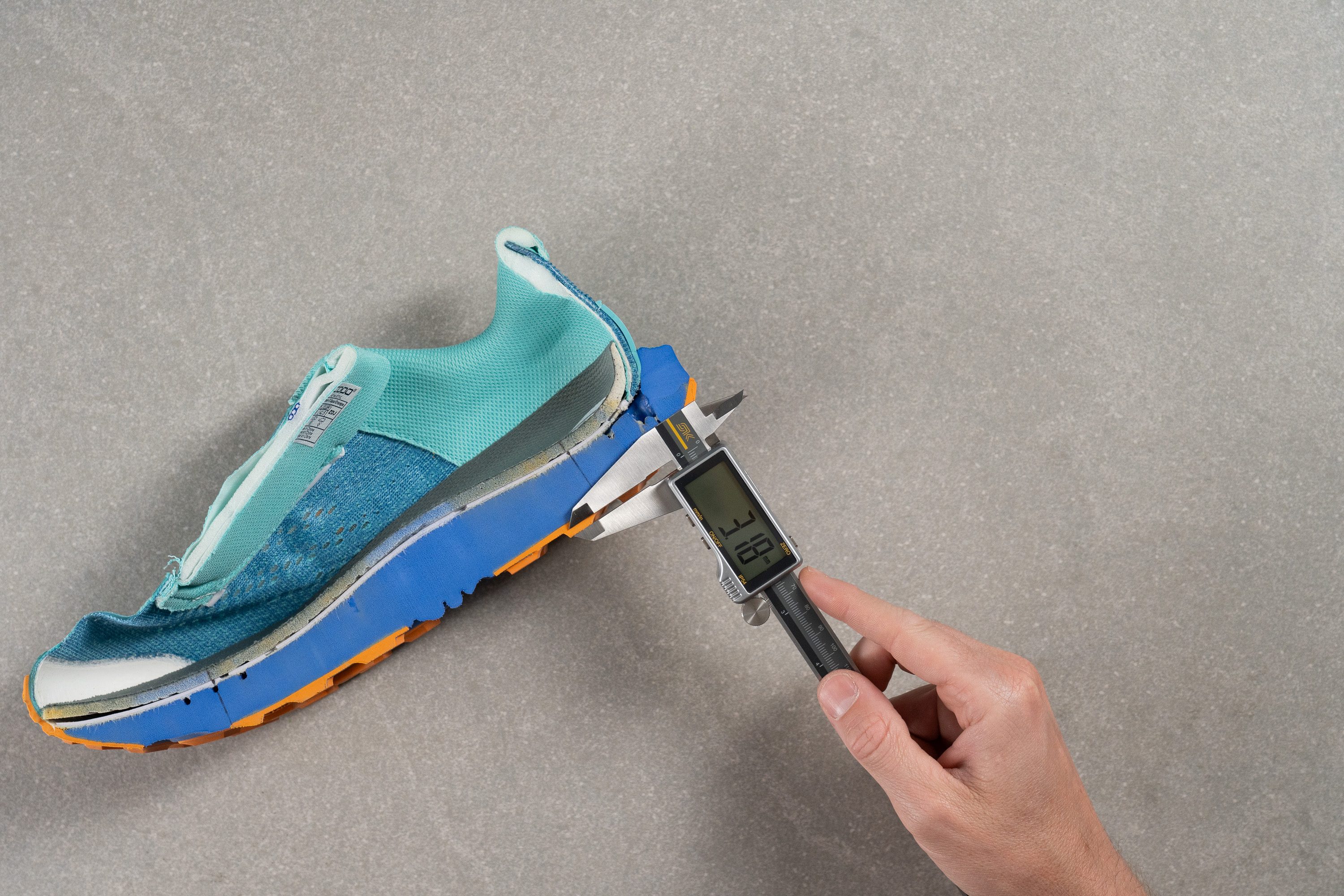
| Topo Ultraventure 4 | 3.2 mm |
| Average | 3.5 mm |
Outsole design
The outsole of the Topo Ultraventure 4 features a Vibram XS Trek compound with three separate rubber segments placed in high-wear areas. It blends durable orange rubber with exposed blue foam through the midfoot and arch, reducing weight and adding flexibility by avoiding a full-length rubber layer.
Both the heel and forefoot showcase trapezoidal lugs with wide spacing. The design clearly favours easy, non-technical trails and transitions smoothly to light road use.

Flexibility / Stiffness
We tested the bend resistance using our 30-degree flex test and measured just 13.1N. That’s really flexible for a shoe featuring nearly 30 mm of forefoot stack height.
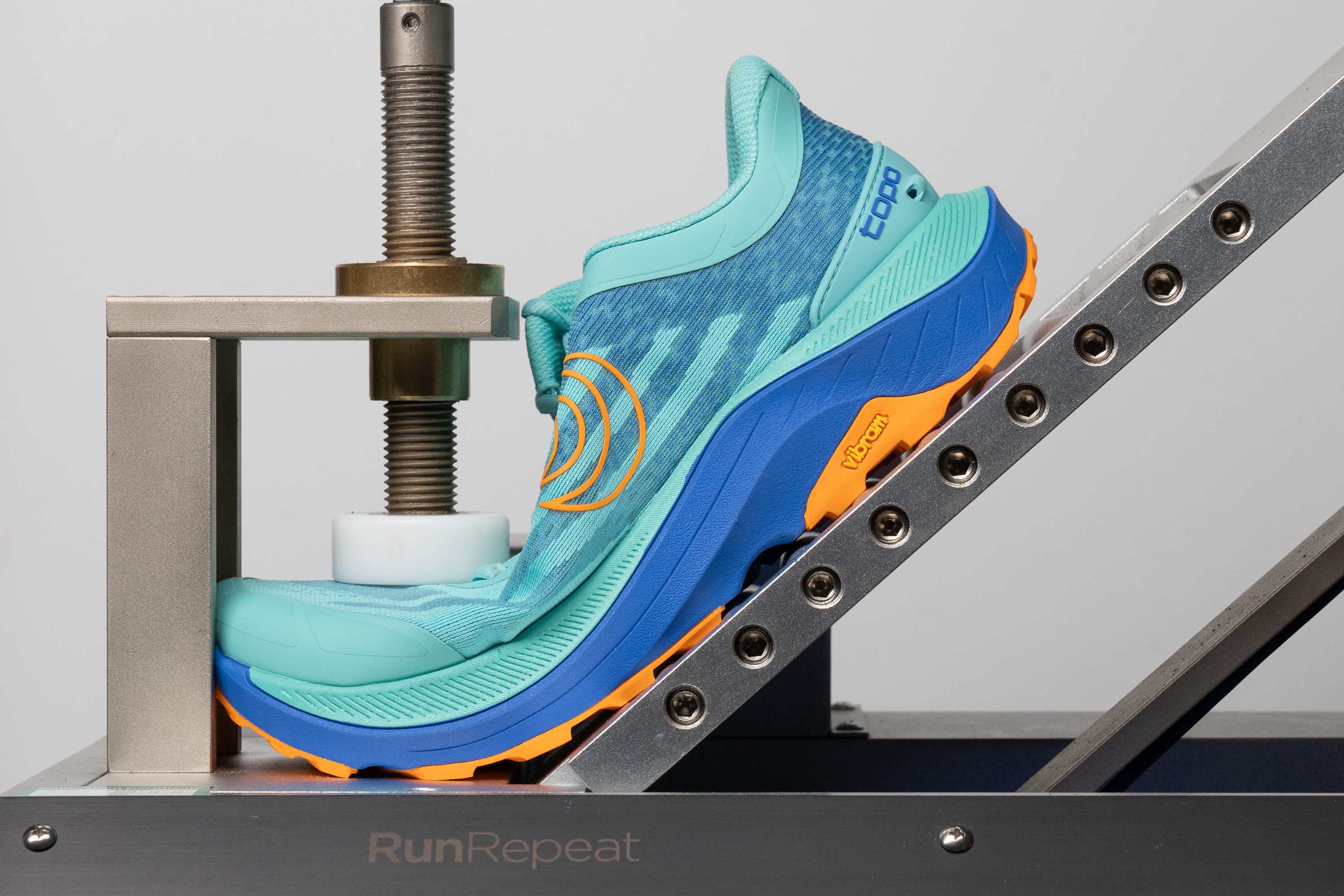
| Topo Ultraventure 4 | 13.1N |
| Average | 14.6N |
Weight
The added stack height came with a slight weight gain compared to version 3. This model now weighs 10.1 oz or 286g, up from 9.75 oz or 276g.
While the difference is minor, we genuinely hope the trend stops here, as one of the best things about the Ultraventure was how much lighter it felt than it looked.

| Topo Ultraventure 4 | 10.1 oz (286g) |
| Average | 10.2 oz (289g) |
Breathability
We tested the Ultraventure 4 using smoke and gave it a 3 out of 5. For us, it's a fair result for an average all-rounder trail shoe. Breathability is decent, but there’s still room for improvement.
Our light test revealed a thinner-than-expected upper that sets it apart from many trail shoes, though it doesn’t translate into standout ventilation based on our previous findings.
Under the microscope, we discovered multiple ventilation holes throughout the upper.
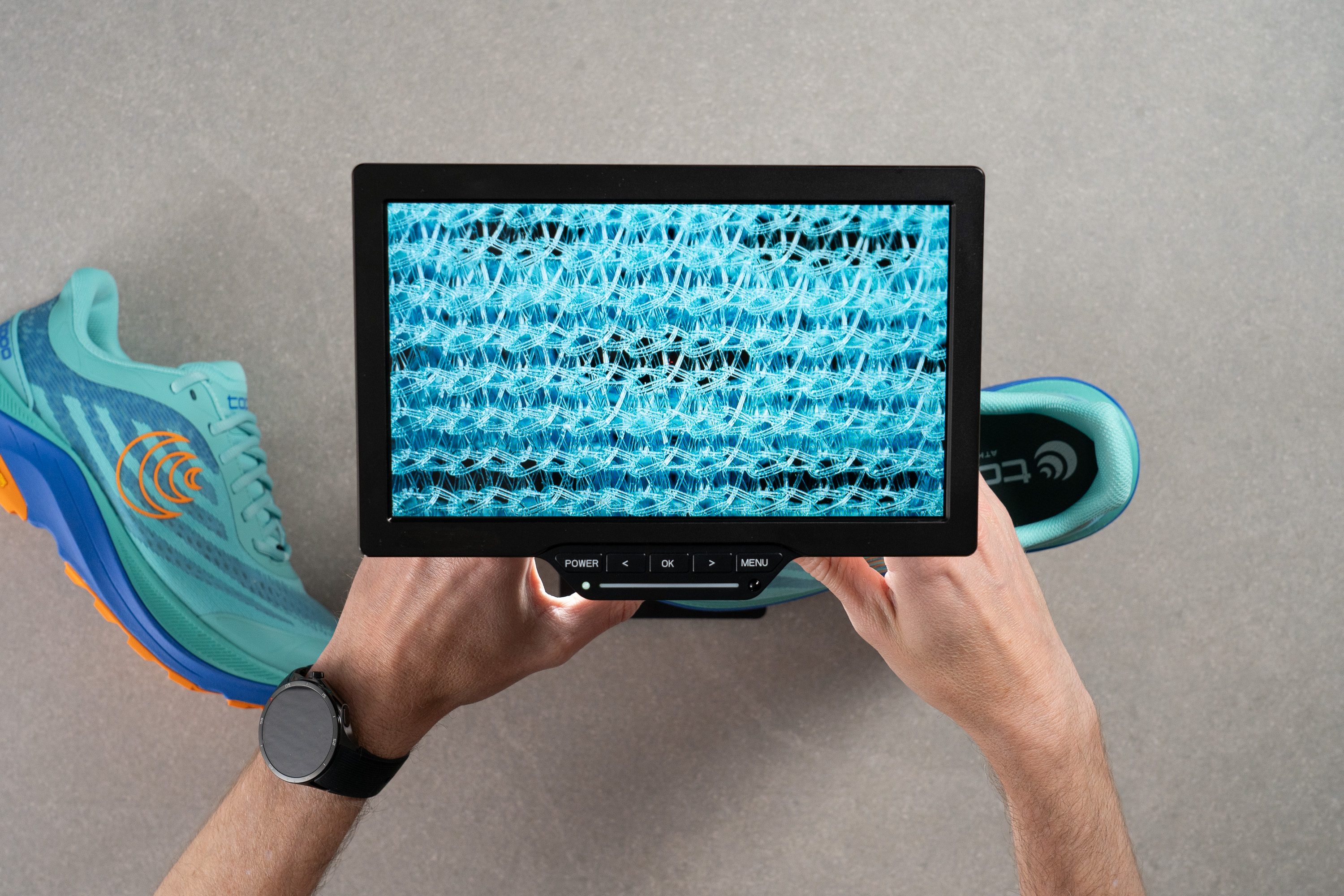
This explains why it avoids a lower breathability rating, but such a design might reduce abrasion resistance too. That's a point we’ll verify during our durability test.
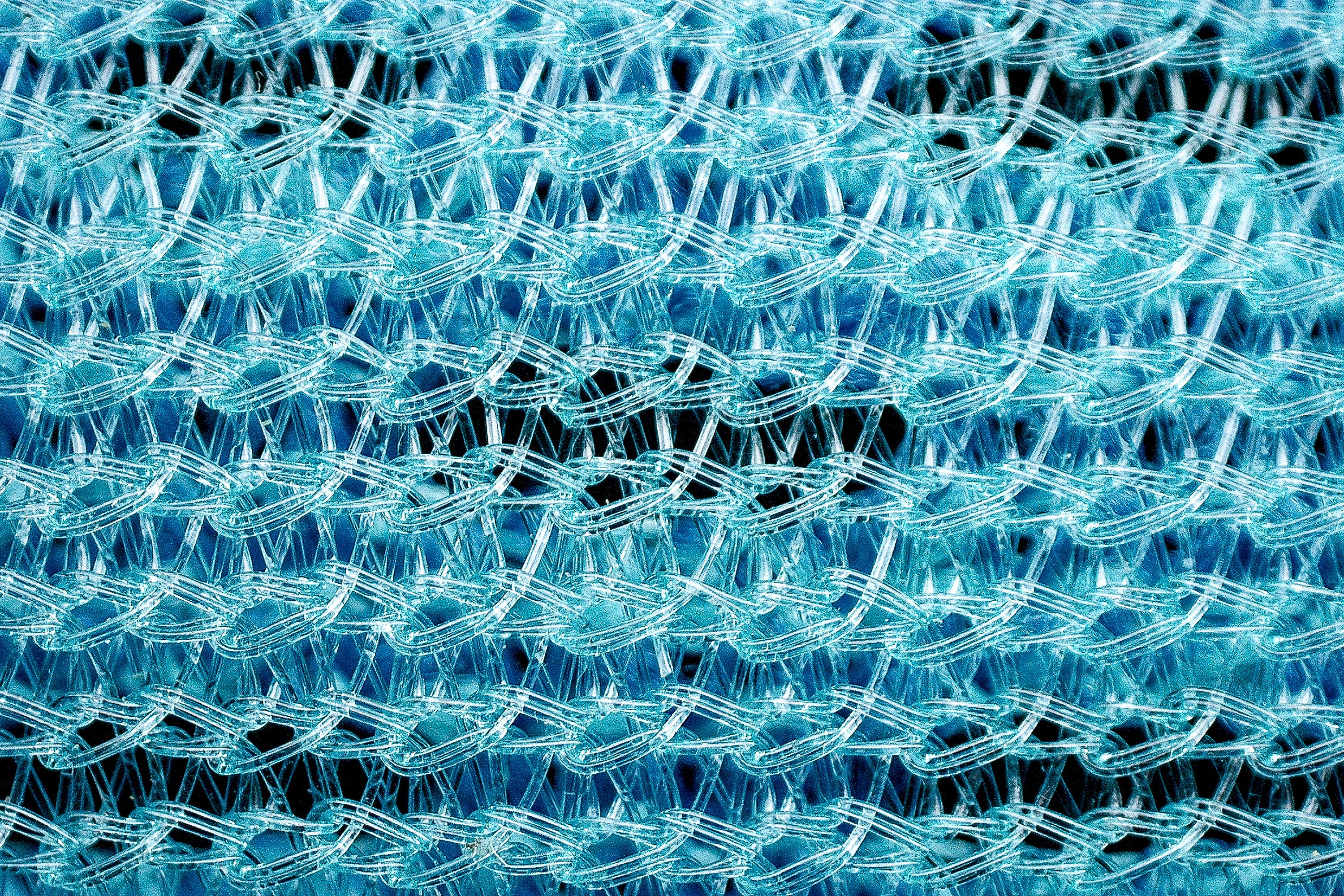
By hand, the upper felt more refined than before. Its slightly-stretchy build and comfort-first padding placement make for a well-executed upgrade.
| Topo Ultraventure 4 | 3 |
| Average | 3.2 |
Stability
Lateral stability test
During our runs with the Ultraventure 4, we found stability to be excellent in the midfoot and forefoot. The heel felt slightly less stable, which was no surprise given Topo’s design priorities, which are usually not aligned with heel strikers.
Torsional rigidity
Interestingly, version 4 scored 3/5 in our torsional rigidity test, compared to the 4/5 we measured on version 3. Beyond the playful symmetry, we see this as a comfort-boosting change that's especially valuable for long ultras.
| Topo Ultraventure 4 | 3 |
| Average | 3.6 |
Heel counter stiffness
The heel counter also gets a slight change, scoring 2/5 in stiffness. This reinforces that Topo isn't aiming to boost heel stability at all. Instead, they clearly expect most runners to land midfoot or forefoot, where a firm heel counter can feel intrusive.
| Topo Ultraventure 4 | 2 |
| Average | 3 |
Midsole width - forefoot
Now we get to the shoe’s dimensions, which once again show its focus on forefoot and midfoot landings.
Rather than sticking to an average width, Topo pushed it to 119.4 mm for ultra-stable support.
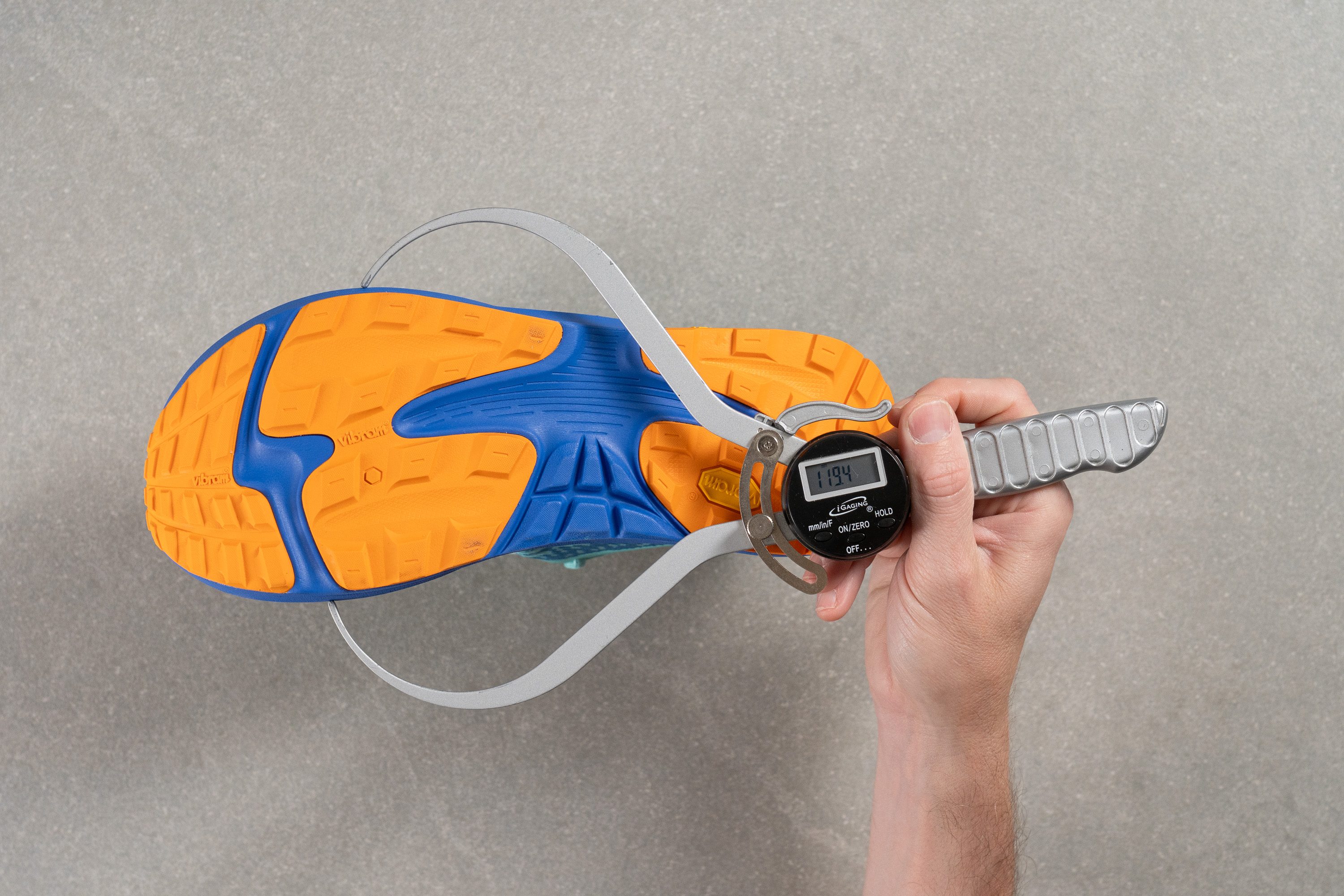
| Topo Ultraventure 4 | 119.4 mm |
| Average | 112.8 mm |
Midsole width - heel
And we found the exact opposite in the heel, with a below-average width of 87.8 mm. This clearly signals to heel strikers that it’s not the ideal choice unless they’re fine with a mid-drop shoe featuring a less-than-stable rearfoot.
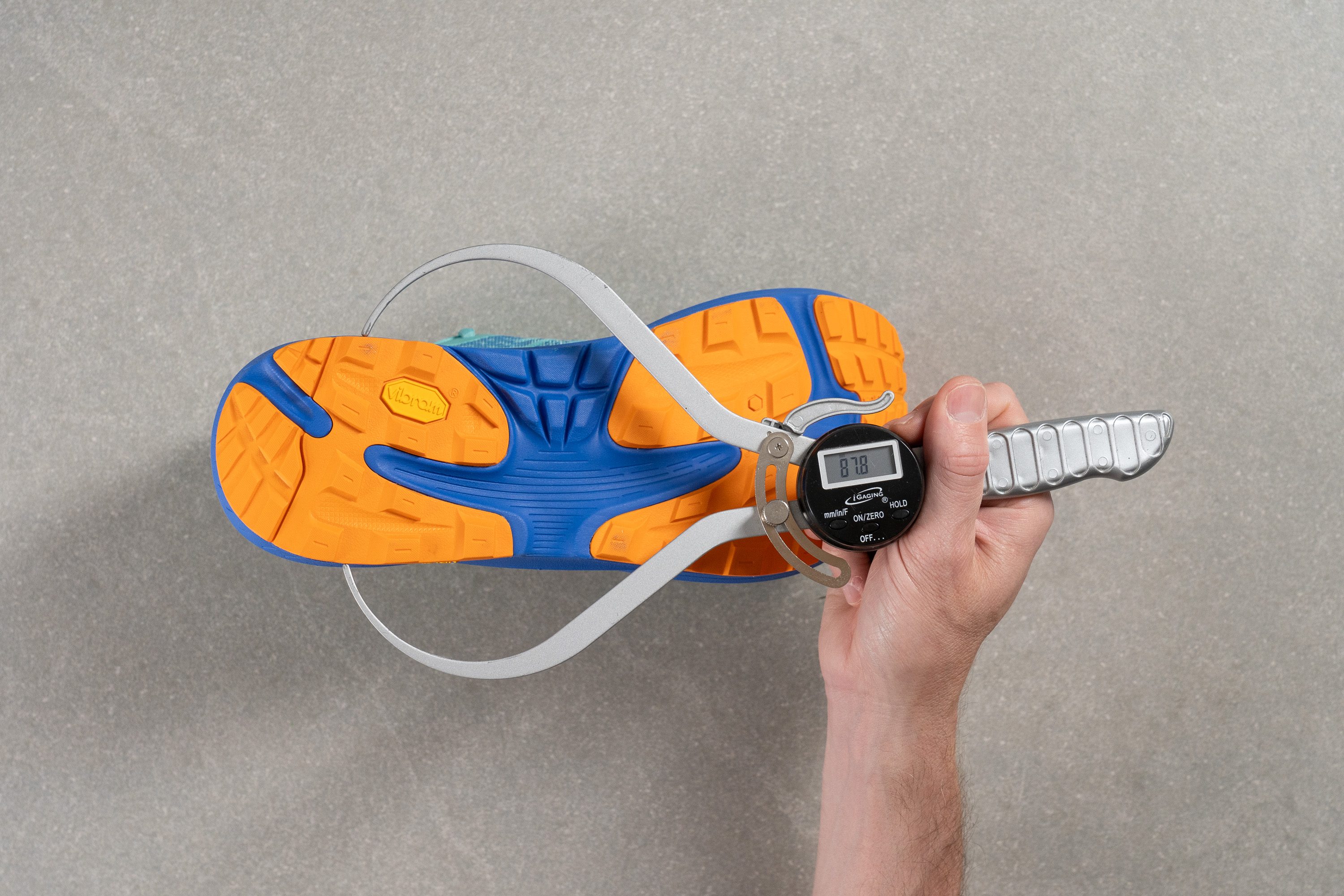
| Topo Ultraventure 4 | 87.8 mm |
| Average | 89.9 mm |
Durability
Toebox durability
We hinted at possible issues during our breathability assessment, and unfortunately we have to confirm that the thin engineered mesh doesn’t offer much resistance to abrasion with a 2/5 score.
Sure, it’s well protected in the toe cap (something we applaud) but this clearly isn’t one of those ultra-rugged trail shoes built like a tank.
| Topo Ultraventure 4 | 2 |
| Average | 3.1 |
Heel padding durability
The same applies to the heel padding, where the Ultraventure 4 scored another 2/5, falling short of what we usually see in an average trail running shoe.
| Topo Ultraventure 4 | 2 |
| Average | 3 |
Outsole durability
Fortunately, the Vibram outsole performed far better than the upper when it came to durability. After testing, we measured just 0.6 mm of wear, which is a solid result that suggests long-lasting potential even for multiple ultra races.
| Topo Ultraventure 4 | 0.6 mm |
| Average | 0.9 mm |
Outsole thickness
The outsole measures 2.1 mm thick, offering ample protection from sharp rocks and trail hazards. This durable layer makes a rock plate unnecessary.
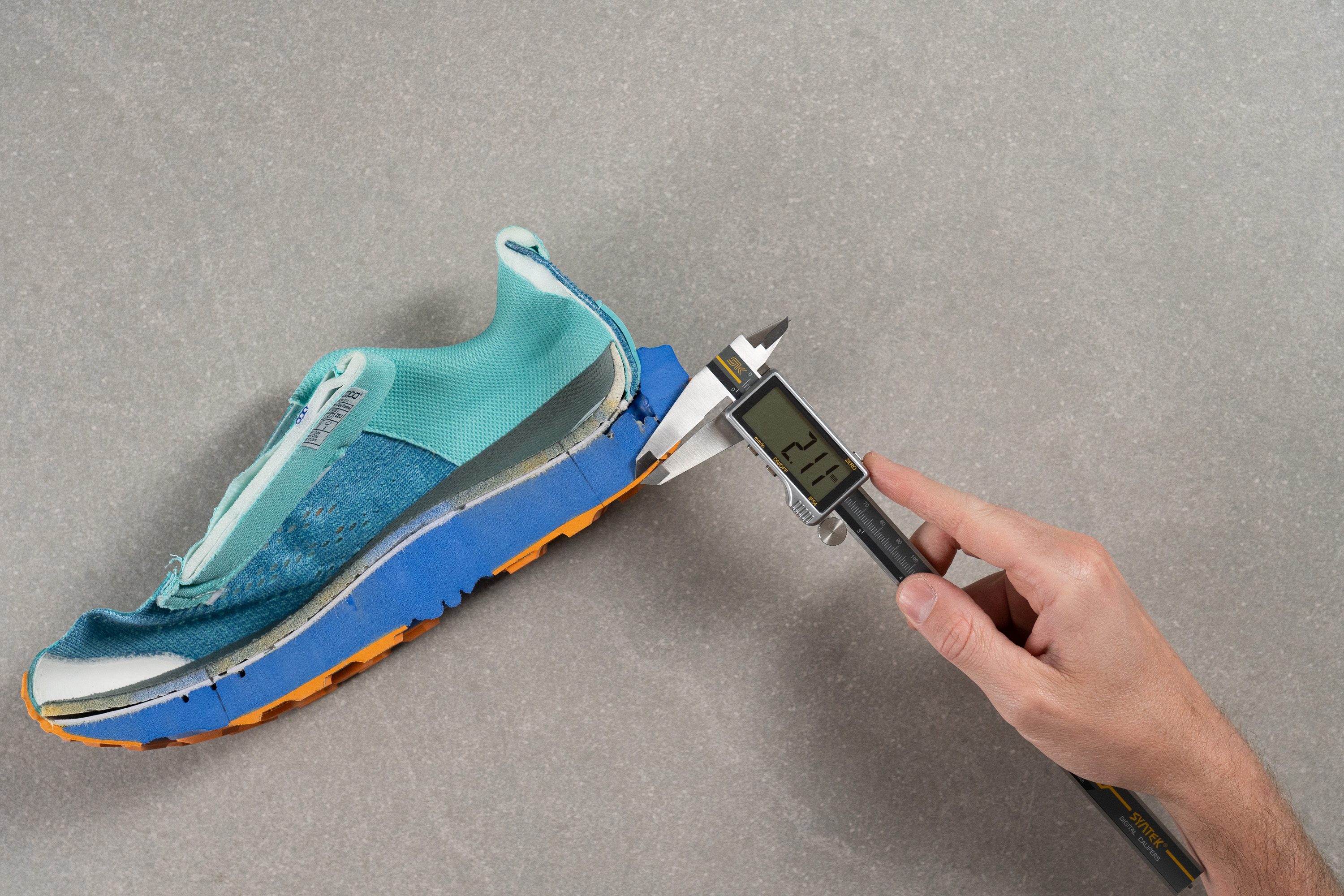
| Topo Ultraventure 4 | 2.1 mm |
| Average | 2.2 mm |
Misc
Insole thickness
The Ortholite insole measures 4.4 mm in thickness, delivering an average layer of comfort that adds a light touch to the shoe’s overall cushioning setup.

| Topo Ultraventure 4 | 4.4 mm |
| Average | 4.7 mm |
Removable insole
You can remove the Ortholite insole and swap it for another, but finding one that matches the uniquely foot-shaped design of the Ultraventure 4 won’t be easy. Just look how unusual and boxy it looks!
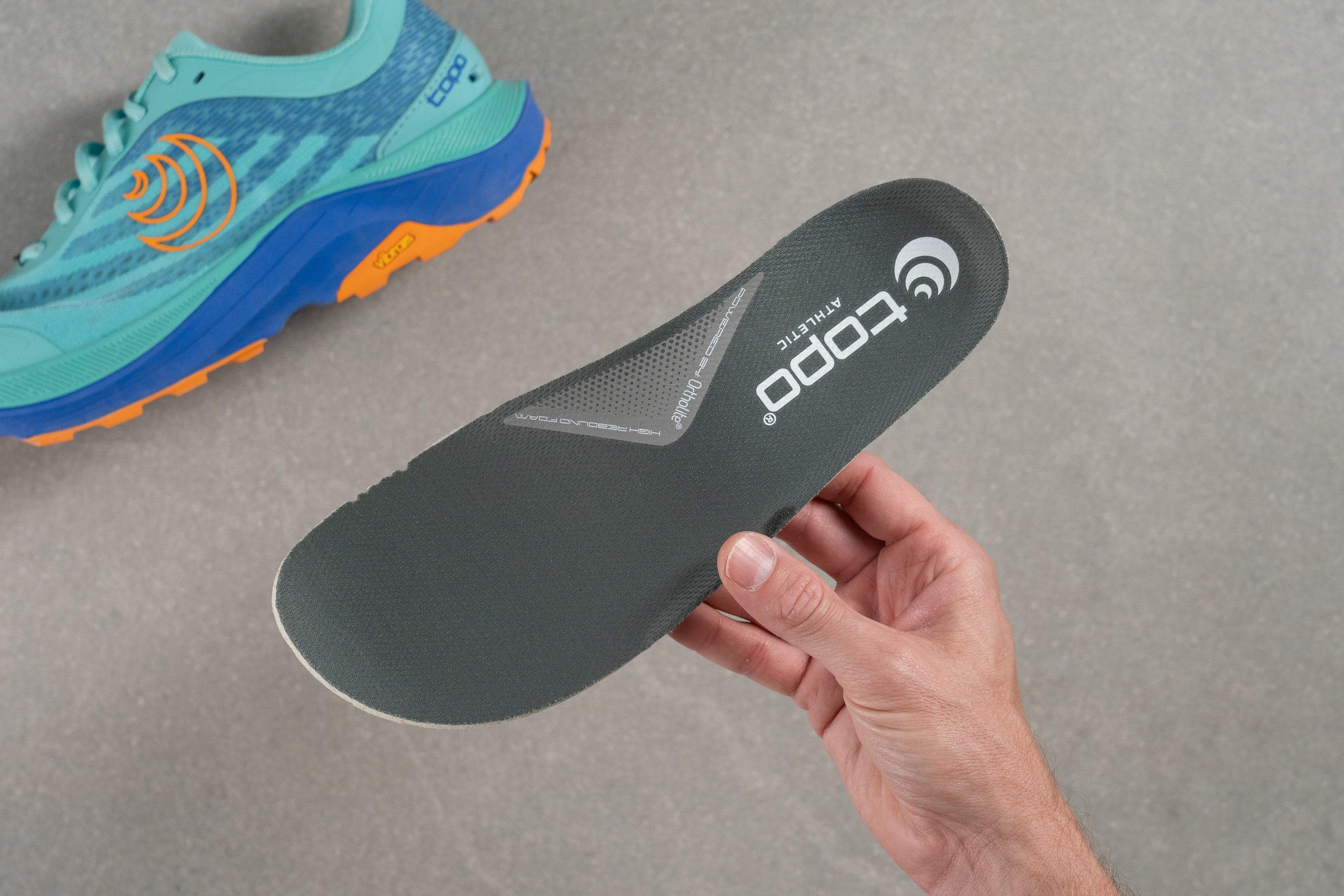
| Topo Ultraventure 4 | Yes |
Midsole softness in cold (%)
We tested the EVA-based ZipFoam midsole to see how it reacts in cold weather. After placing the shoe in the freezer for 20 minutes, we discovered it became 21% firmer.
| Topo Ultraventure 4 | 21% |
| Average | 26% |
Reflective elements
Back in our version 3 review, we were hoping Topo would finally add reflective elements to version 4. However, it looks like we’ll have to wait at least until v5.
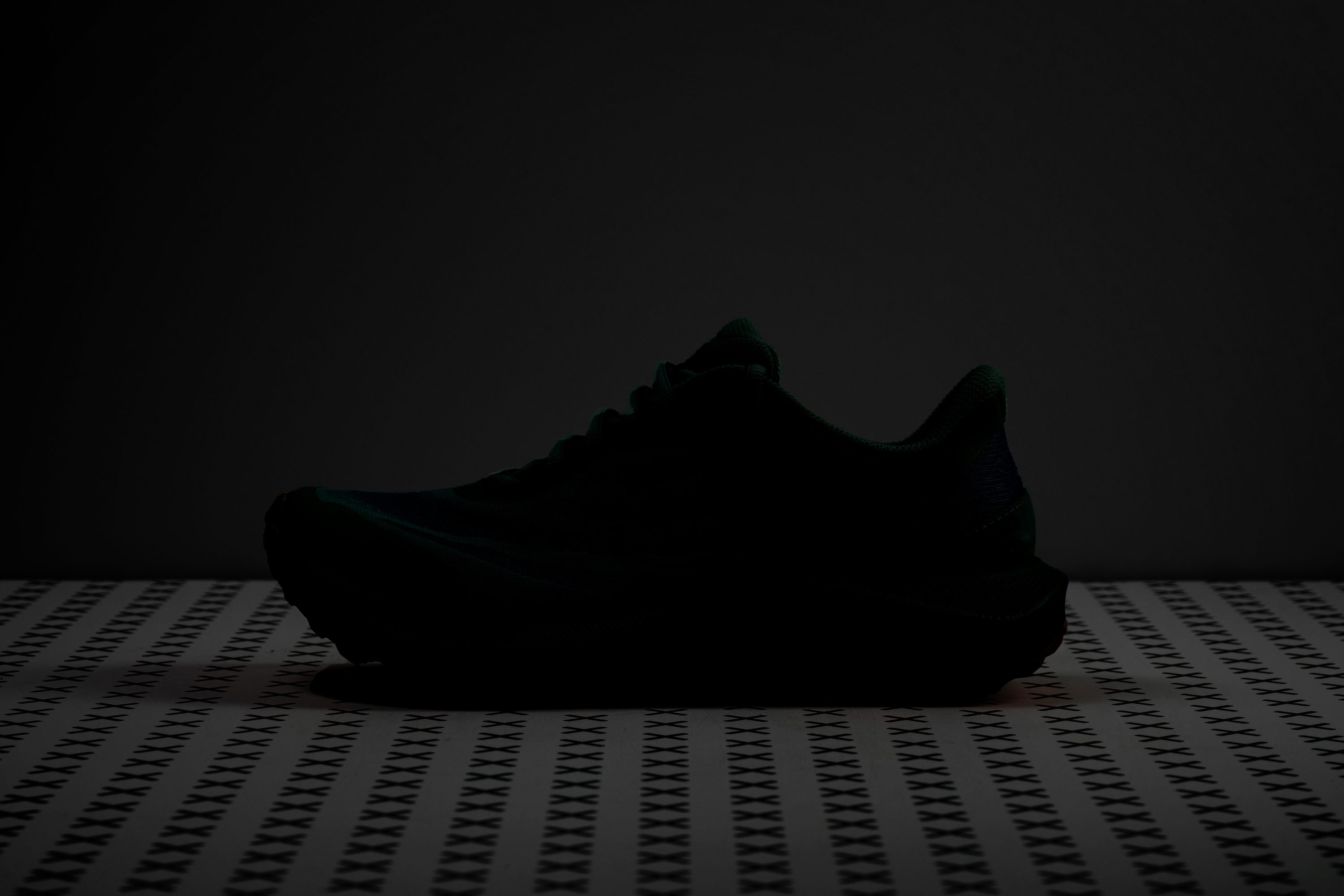
| Topo Ultraventure 4 | No |
Tongue padding
One of the biggest changes we discovered is the plush-and-padded tongue in version 4, now reaching 7.9 mm of foam that softens pressure even with a tight knot.
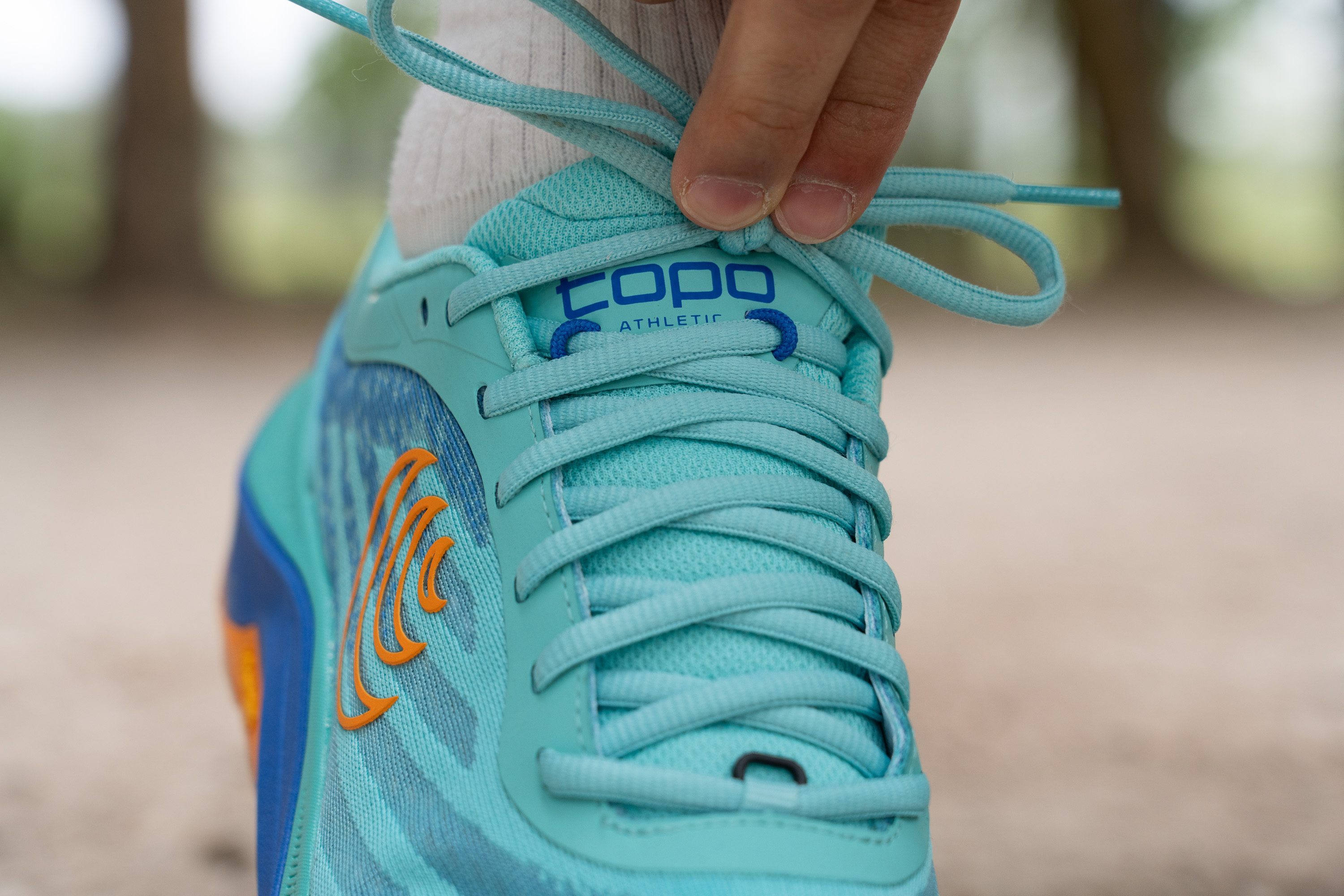
The lacing is reinforced with a tear-resistant TPU patch and strong rounded laces that, in our view, could use a more trail-ready look. We also found Topo’s signature dual-loop setup at the top of the tongue.
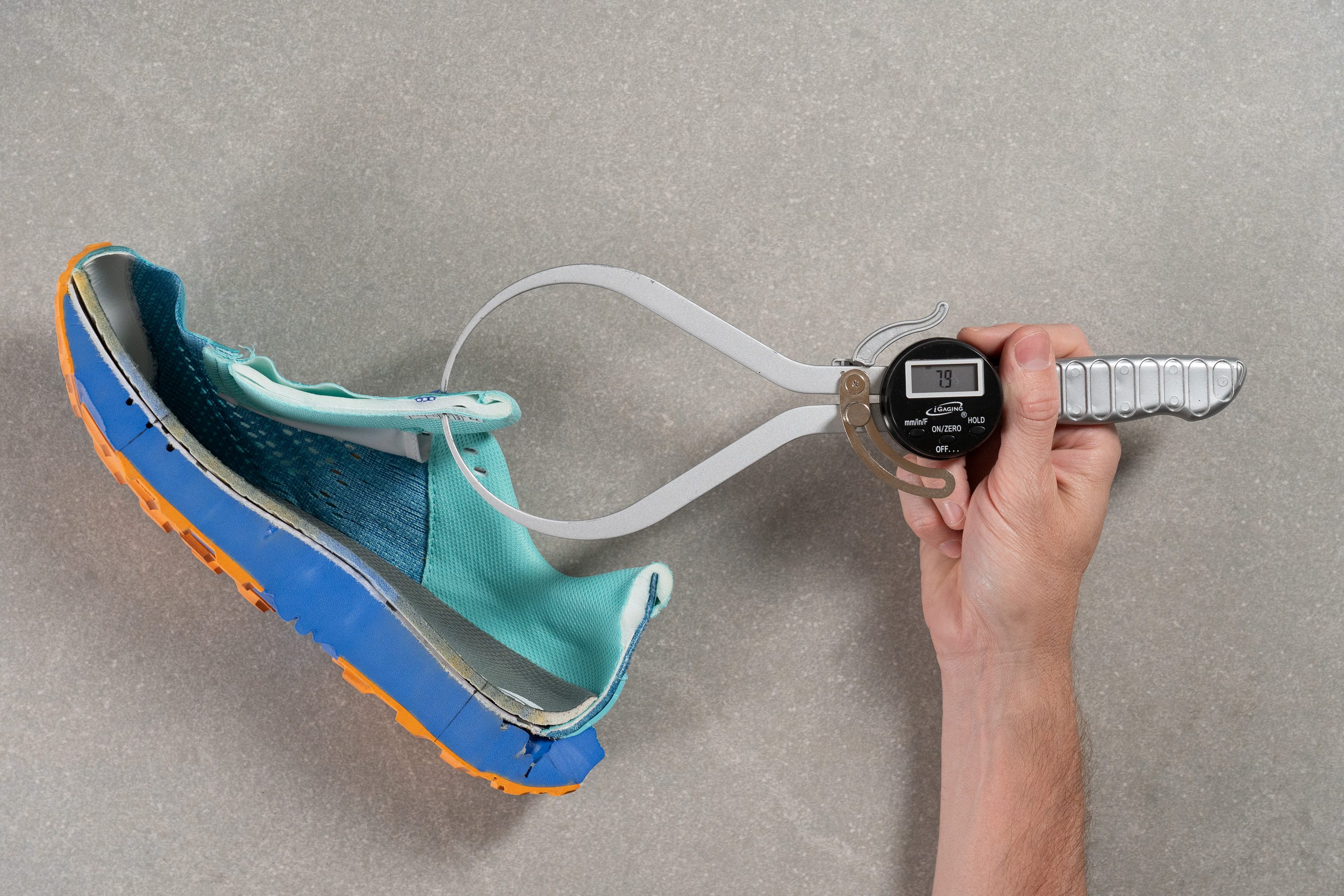
| Topo Ultraventure 4 | 7.9 mm |
| Average | 6.4 mm |
Tongue: gusset type
The tongue is fully gusseted so it blocks debris and improve lockdown. We’re glad to see it checks this box.
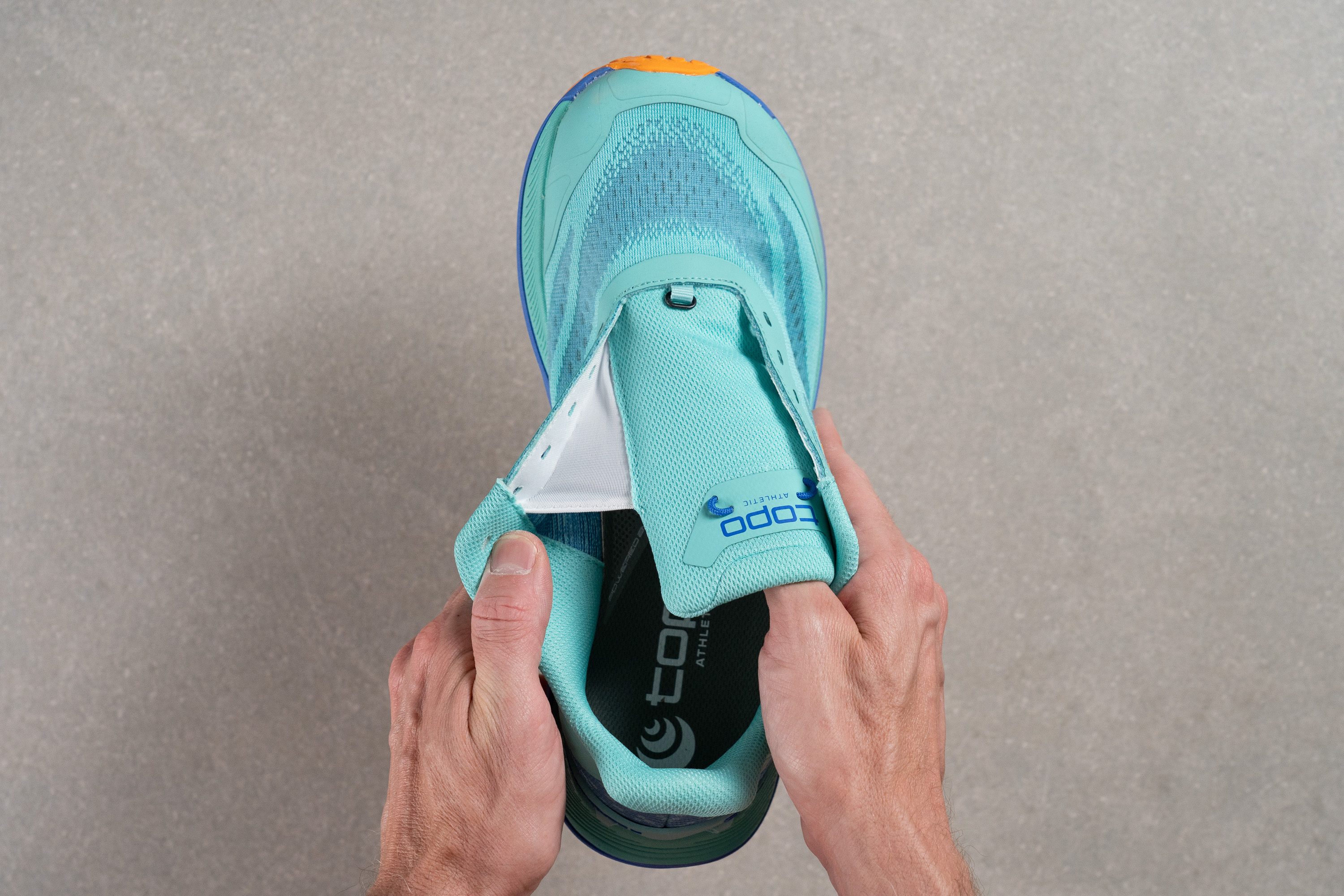
| Topo Ultraventure 4 | Both sides (full) |
Price
We think Topo set a fair price for the Ultraventure 4 considering its features, especially the premium Vibram outsole. However, its low energy return holds it back, and we believe they need to raise the bar in that area to compete as a true value-packed option.
| Topo Ultraventure 4 | $150 |
Heel tab
The Ultraventure 4 skips the heel tab, which might seem unusual since most trail shoes include one.

| Topo Ultraventure 4 | None |

